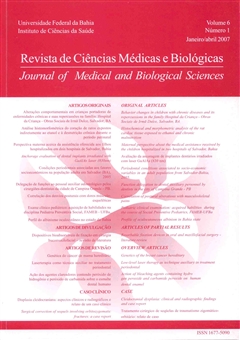Dispositivos bioabsorvíveis de fixação em cirurgia bucomaxilofacial – revisão de literatura
DOI:
https://doi.org/10.9771/cmbio.v6i1.4266Palabras clave:
cirurgias maxilofaciais, fixação interna rígida, fixação reabsorvível, fixação óssea.Resumen
A preocupação quanto ao tratamento das fraturas faciais é registrada desde a antiguidade até os dias atuais. A literatura demonstra o crescente desenvolvimento de técnicas e materiais utilizados para esse fim, constatando-se uma gradativa alteração dos tratamentos empíricos, baseados em evidências científicas. Os materiais inicialmente descritos variavam desde o uso de bandagens, tiras de couro extra-orais, calhas fabricadas através de chifres de animais até a utilização do metal no tratamento fechado e aberto das fraturas. Através dos avanços tecnológicos utilizados na produção dos sistemas de fixação, passou-se a utilizar materiais que fossem bem aceitos pelo organismo, como o sistema de placas e parafusos metálicos. Mais recentemente, outro sistema foi introduzido no mercado, os materiais de fixação bioabsorvíveis. Desde então, trabalhos vêm sendo desenvolvidos com o intuito de formular um protocolo de utilização, testar os novos materiais e ressaltar suas principais indicações e possíveis desvantagens. Este trabalho tem como objetivo fazer um breve relato histórico sobre a evolução dos materiais utilizados nas cirurgias maxilofaciais, além de revisar tópicos relevantes em relação às placas e parafusos bioabsorvíveis.Descargas
Los datos de descargas todavía no están disponibles.
Descargas
Publicado
2007-07-14
Cómo citar
Silveira, R. L., Maia, B. F., Machado, R. A., Weigert, F. B., & Oliveira, R. B. de. (2007). Dispositivos bioabsorvíveis de fixação em cirurgia bucomaxilofacial – revisão de literatura. Revista De Ciências Médicas E Biológicas, 6(1), 76–85. https://doi.org/10.9771/cmbio.v6i1.4266
Número
Sección
Artigos de divulgação
Licencia
A Revista de Ciências Médicas e Biológicas reserva-se todos os direitos autorais dos trabalhos publicados, inclusive de tradução, permitindo, entretanto, a sua posterior reprodução como transcrição, com a devida citação de fonte. O periódico tem acesso livre e gratuito.






